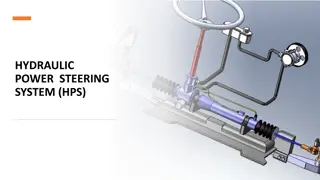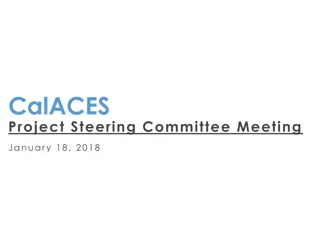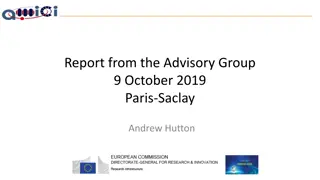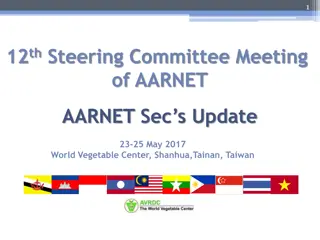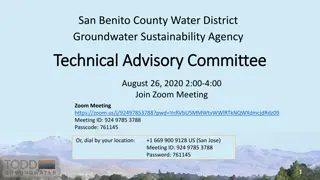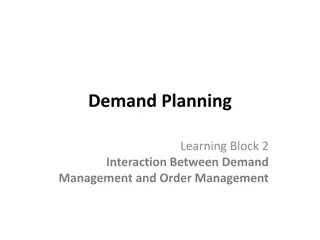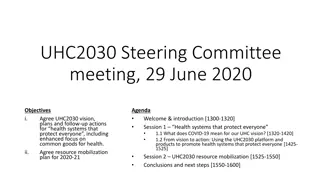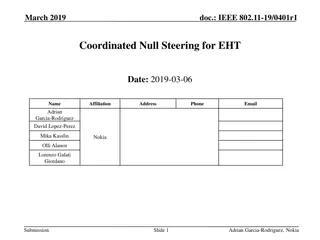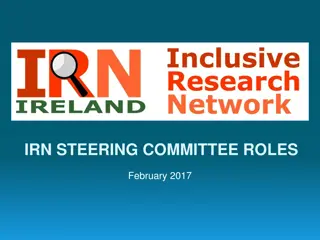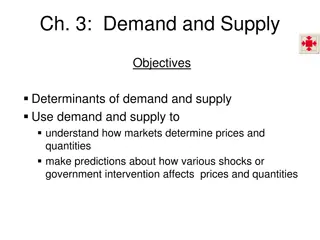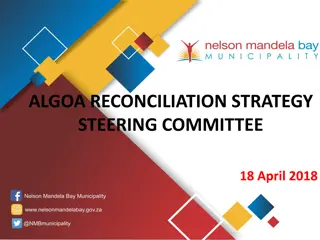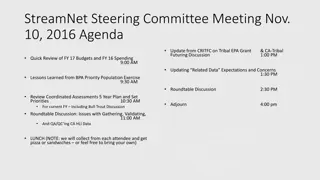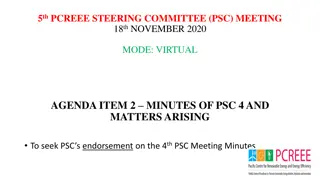ESJ 2025 GSP: Steering Committee Meeting on Demand Management
This meeting discusses the need for a demand management program in light of uncertain water availability, focusing on strategies like demand reduction and pumping offset. It presents conceptual models of reduced pumping, increased recharge, and projected conditions to address water challenges effectively.
Download Presentation

Please find below an Image/Link to download the presentation.
The content on the website is provided AS IS for your information and personal use only. It may not be sold, licensed, or shared on other websites without obtaining consent from the author.If you encounter any issues during the download, it is possible that the publisher has removed the file from their server.
You are allowed to download the files provided on this website for personal or commercial use, subject to the condition that they are used lawfully. All files are the property of their respective owners.
The content on the website is provided AS IS for your information and personal use only. It may not be sold, licensed, or shared on other websites without obtaining consent from the author.
E N D
Presentation Transcript
ESJ 2025 GSP Update Steering Committee Meeting Special Topic: Demand Management August 14, 2024 1
Meeting Purpose Hear presentation on recent work related to a demand management policy Agree on recommendation for GWA Board Meeting 2
Need for Demand Management Program No guarantees of future hydrology or surface water availability DWR/SWRCB has indicated need for demand management/pumping reduction program as backstop against non/under-performance of projects Need to be able to focus reductions locally within the basin in addition to basin-wide Formal mechanism to allow for adaptive management 3
Brief Note on Nomenclature Demand reduction Limited options that really point to land fallowing/repurposing Pumping reduction AKA groundwater demand reduction (groundwater offset) Could be achieved with land fallowing/repurposing, changes in land use OR bringing in more surface water anything that reduces or offsets pumping Model calculations adjust land use, so are more accurately described as demand reduction numbers 4
Conceptual Model Of the Open Subbasin Reduced Pumping Existing Pumping Stream Change in Storage Stream Boundary Conditions Boundary Conditions Delta Delta Flow to neighboring Subbasins Flow to neighboring Subbasins Change in Pumping (AFY) Change in Storage (AFY) 5
Conceptual Model Of the Open Subbasin Increased Recharge Existing Pumping Existing Pumping Stream Change in Storage Stream Boundary Conditions Boundary Conditions Delta Delta Flow to neighboring Subbasins Flow to neighboring Subbasins Groundwater Recharge (AFY) Change in Storage (AFY) 6
Conceptual Model Of the Open Subbasin Projected Conditions Baseline (PCBL) Base case for projected conditions Includes projected changes in land use, urban water demand, surface water supply and deliveries Uses 1969-2023 hydrology Projected Conditions Baseline with Climate Change (PCBL-CC) Same as #1 but with added multipliers to simulate climate change Projected Conditions Baseline with Projects & Management Actions (PCBL-PMA) Same as #1 but also simulating PMAs Projected Conditions Baseline with Climate Change and Projects & Management Actions (PCBL-CC-PMA) Same as #1 but with added climate change multipliers and simulating PMAs Projected Conditions Baseline with Demand Reduction (PCBL-DR) Same as #1 but with artificial demand reduction by user type 1. 2. 3. CC 4. PMAs 5. PCBL 7
Projected Conditions Baseline with Demand Reduction (PCBL-DR) PCBL but with artificial demand reduction by user type No PMA simulation applied Used to estimate the volume of pumping reduction required to achieve a 0 AFY change in storage Run with and without climate change Percent Reduction PCBL- DR 0% PCBL- CC-DR 0% Ag GW Pumping <2 AF/acre Ag GW Pumping 2- 3 AF/acre Ag GW Pumping >=3 AF/acre Urban Demand 15% 25% 38% 28% 15% 15% 8
Work Context Simplified Groundwater System Projected Conditions Baseline With Climate Change and Demand Reduction (AF/year) 55 Years with 2070 CT Projected Conditions Baseline with Demand Reduction (AF/year) Projected Conditions Baseline With Climate Change (AF/year) Projected Demand Reduction Impact on Subbasin Water Budget Component Conditions Baseline (AF/year) Hydrologic Period 55 Years 55 Years 55 Years with 2070 CT Inflows Deep Percolation Stream Seepage Other Recharge Carriage/Canal Recharge Managed Aquifer Recharge Reservoir Seepage Ungauged Watershed Drainage Subsurface Inflow Total Inflow Outflows Groundwater Outflow to Streams Groundwater Pumping Agricultural Urban and Industrial Subsurface Outflow Total Outflow 270,000 297,000 165,000 98,000 11,000 14,000 45,000 204,000 935,000 247,000 273,000 165,000 99,000 11,000 13,000 45,000 188,000 872,000 268,000 329,000 168,000 98,000 11,000 14,000 48,000 222,000 987,000 234,000 283,000 168,000 98,000 11,000 13,000 48,000 193,000 878,000 Less groundwater pumping under demand reduction Without climate change, 95,000 AF/year (12%) With climate change, 166,000 AF/year (19%) 9 57,000 799,000 732,000 67,000 110,000 965,000 61,000 704,000 639,000 65,000 107,000 872,000 53,000 879,000 812,000 67,000 111,000 1,043,000 60,000 713,000 648,000 65,000 105,000 878,000 Change in Groundwater Storage (Inflows Minus Outflows) Change in Groundwater Storage -30,000 0 -56,000 0
Work Context Developed water budgets show a -30 TAFY change in storage under future baseline conditions (PCBL) Increases to -56 TAFY with climate change added (PCBL-CC) Need to understand what this deficit means in terms of a pumping reduction Note: Neither Pumping reduction nor groundwater recharges results in a 1-for-1 with change in storage reduction 10
166 TAF: Full demand reduction w/ climate change (before crediting for PMAs) 95 TAF: Full demand reduction w/o climate change (before crediting for PMAs) At 56 TAF of demand reduction, there is -37,000 AFY change in storage Impact of Climate Change At 56 TAF of demand reduction, there is -12,000 AFY change in storage 11
Summary: Average Annual Change in Storage with and without Climate Change 1. Reduce Pumping by 0 AFY Without Climate Change: -30 TAFY change in storage With Climate Change: -56 TAFY change in storage 2. Reduce Pumping by 56 TAFY Without Climate Change: -12 TAFY change in storage With Climate Change: -37 TAFY change in storage 3. Reduce Pumping by 95 TAFY Without Climate Change: 0 TAFY change in storage With Climate Change: -25 TAFY change in storage 4. Reduce Pumping by 166 TAFY Without Climate Change: 23 TAFY change in storage With Climate Change: 0 TAFY change in storage 12
Recommendations Recommend using PCBL scenario to assess demand reduction impacts Basin needs to reduce groundwater demand by 95 TAF to avoid undesirable results for sustainability indicators A 56 TAFY demand reduction gets us from a -30 TAF annual change in storage to -12 TAF 13
Working Towards Meeting the 95 TAFY Pumping Reduction Within the model margin of error could be met with more demand reduction or more PMAs 6 TAFY 39 TAFY Further demand reduction or PMAs 33 TAFY 2024 PMAs 95 TAFY Reduction needed for 0 annual average change in storage PCBL No climate change No PMAs 56 TAFY Initial demand reduction allocated 56 TAFY Demand reduction < -9 TAFY Annual change in storage -12 TAFY Annual change in storage -30 TAFY Annual change in storage 14
Concept: No DR until after 2030 2024 2025 2026 2027 2028 2029/2030 6 TAFY 56 TAFY Initial demand reduction allocated 95 TAFY Reduction needed for 0 annual average change in storage 33 TAFY 2024 PMAs 2024 PMAs 2024 PMAs 2024 PMAs -30 TAFY Annual change in storage < -9 TAFY Annual change in storage More projects online No demand reduction 15
PMC Discussion Summary Asking basin to reduce by 56 TAFY starting next year will be difficult and economically challenging Proposed schedule: 2025-2030: Develop demand management policy 2031-2040: Implement demand management policy Starting the 56 TAFY post 2030 gives time for those who have not implemented PMAs to do so before being required to reduce demand May not need 56 TAFY, may need something less than that it all depends on the hydrology Key is adaptive management 16
PMC Discussion Summary DWR is looking for a commitment that the basin will be adaptively managed (seeing this in other basins) New management action: demand management plan for 2025 2030 Need to have a strong, clear story about the work the basin has been doing to adaptively manage demand in the last 5 years Planning, funding, and building PMAs Well mitigation program Crop removal Demand management plan for 2025 2030 (new management action) 17
Looking for Steering Committee Recommendation to Take to GWA Board 1. Develop policy by 2030, implement post 2030 to reach sustainability by 2040 2. Craft clear story of the work the basin has been doing to adaptively manage GWL levels 3. Add in new management action around developing a demand management policy before 2030 update 18
An Iterative Process Annual Commitment through 2040: 2028/29: Finalize demand management policy & implementation plan Initiate 2030 GSP Update Include model refinement in annual workplans 2030: 2030 GSP Update Complete Implement demand management policy Refine method of allocating overdraft among GSAs Recalculate target pumping reduction 19




